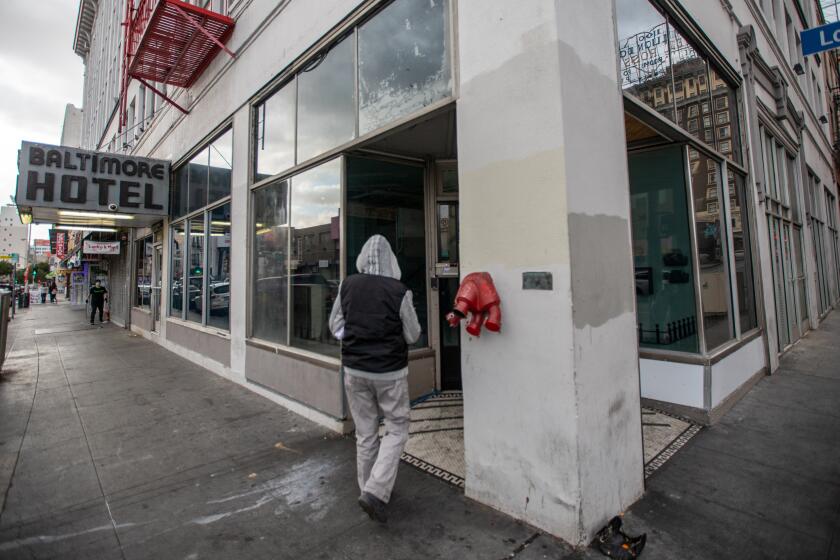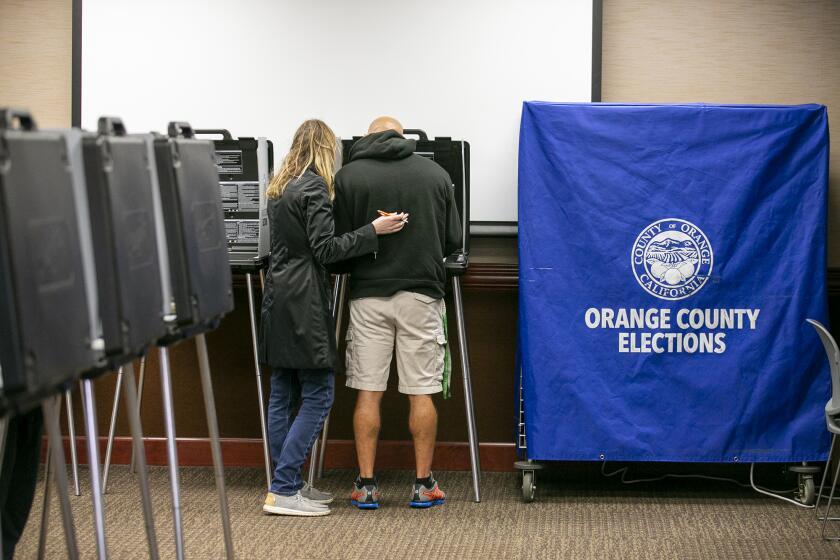Challenges accelerate for transit
For decades, California officials complained that efforts to get traffic moving were stymied by a lack of money.
But with apparent voter approval Tuesday of massive new financing schemes for both the state and Los Angeles County, transportation planners suddenly and somewhat unexpectedly have tens of billions coming for an array of rail, bus and traffic improvement projects. The gusher of tax dollars offers a rare chance to fix crucial parts of a transportation network choking on too many cars and commuters, experts say.
Simultaneous approval of a high-speed rail line to link California’s two major cities and a package of subway, light rail, highway and busway expansions in the state’s most populous county marks “a huge step forward,” said Dario Frommer, a member of the California Transportation Commission.
In Los Angeles, where voters agreed to increase sales taxes to pay for up to $40 billion in projects, “we have a huge opportunity to transform [the county] in a way that’s never been done before,” said Richard Katz, a Metropolitan Transportation Authority board member and transit advisor to Mayor Antonio Villaraigosa. “Without being overly dramatic, this is as significant on the local level as Barack Obama’s election on the national level.”
But now comes the more sobering, slogging challenge: delivering on the ambitious -- even grandiose -- expectations raised by the Proposition 1A and Measure R campaigns.
“We are not out of the woods yet in terms of stabilizing and securing all the funding necessary for these projects,” said Frommer, former majority leader of the state Assembly.
One growing concern: State and federal lawmakers could pull back existing and anticipated matching funds for transportation projects because of the nation’s deepening economic crisis.
Indeed, the timing of the two transportation ballot measures, along with construction schedules and promises of congestion relief, were based in part on plans to wring more money from other sources. Chief among them is a giant federal transportation bill -- the first since 2005 -- to be crafted by Congress next year.
But state and federal lawmakers face major budget deficits, coupled with declines in transportation tax dollars from gasoline sales, which have dropped as motorists drive less.
Even with the new ballot measure money, including nearly $10 billion for the bullet train from the Bay Area to Southern California, some projects could be delayed or in jeopardy if current transportation allotments are cut back, Frommer said. “It’s very complicated.”
With 100% of precincts reporting, Measure R narrowly exceeded the two-thirds vote required; the thousands of provisional and absentee ballots that remained to be counted were not expected to change the outcome. Proponents declared victory.
At a Measure R news conference in the Wilshire Center, where the western spur of the Los Angeles subway ends, the head of the MTA told reporters that extension of a line to the Westwood-UCLA area could take 20 years.
Hearing that, Villaraigosa quickly stepped to the microphone and vowed that he and other elected officials would aggressively pursue federal dollars to speed up the project.
“This is a big, physical project that we can’t do overnight,” MTA chief executive Roger Snoble later said. “There’s a lot to it.”
But other local projects could begin relieving congestion within a year, officials said. Millions of dollars will begin flowing to cities, which can synchronize traffic signals, install left-turn lanes and pay for other improvements to unclog traffic, Katz said.
Villaraigosa, who led the Measure R campaign, said Wednesday that the Gold Line light rail extension to the San Gabriel Valley would probably be one of the first projects built, along with the Expo Line from Culver City to Santa Monica. Both of those projects can now be paid for with local money and move ahead quickly, Katz said.
There are still considerable obstacles for many projects. The first phase of the Expo Line is mired in a dispute over a pair of pedestrian crossings in South Los Angeles that could take months, if not years, to resolve.
Another Measure R project, the Green Line rail extension to Los Angeles International Airport, still needs a commitment from the airport to build a people-mover system to get travelers from the train station to the terminals.
Even if all goes well for the proposed 220 mph bullet train down the spine of the state, it won’t be completed for at least 10 years, though some parts will be ready sooner. The first phase is supposed to wind from Anaheim through Los Angeles to Palmdale, then up the Central Valley to San Francisco.
But questions remain about potential cost overruns and funding shortfalls. The initial leg alone is expected to cost millions of dollars more than the $9.95 billion in bonds that voters approved on Tuesday, meaning the state will have to find a partner in the private sector for a venture many view as financially risky.
“Even if nothing at all happens for years, this project will hang over our community, our towns and our state forever, like the mythical sword of Damocles, never actually going away but possibly never coming into existence,” said Martin Engel, a longtime opponent. “It will be eternally short of funding; a bottomless hole in the ground.”
Quentin Kopp, chairman of the state’s high-speed rail authority, vowed to “ride herd” on costs.
He said doubters who claim the trains will cost more and deliver less speedy times than promoters predict are discounting positive reviews of California’s plan by high-speed rail experts from France, Japan and Spain.
The rail line will support greater housing density near stations and decrease pollution, he believes. “With the increasing California population,” Kopp said, “it’s inevitable.”
Whatever the challenges, the voter approval of the transportation measures reflects broad public frustration and a demand for action, officials said.
“People are sick and tired of traffic,” said Los Angeles County Supervisor Zev Yaroslavsky, a key Measure R backer. “They were willing to pay for it. . . . Our job is to deliver on the promises.”
--
steve.hymon@latimes.com
eric.bailey@latimes.com
--
BEGIN TEXT OF INFOBOX
Transportation decisions
MEASURE R
Allocation: Up to $40 billion for L.A. County transportation projects.
Choices: Prioritizing a long list of projects, including the expensive “Subway to the Sea.”
PROPOSITION 1A
Allocation: $9.95 billion for California high-speed rail.
Choices: Finding partners, perhaps from private sector, to help pay for bullet train.
Source: Times reporting
More to Read
Start your day right
Sign up for Essential California for news, features and recommendations from the L.A. Times and beyond in your inbox six days a week.
You may occasionally receive promotional content from the Los Angeles Times.






